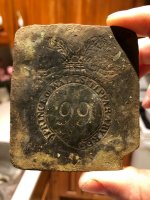pcolaboy
Hero Member
This is going to be a rather vague topic so please bear with me.
Occassionally I run across ballast piles on sandbars in my local bay waters. Whether or not these are places where ballast was simply dumped overboard or left from a wreck remains to be determined on most of them. Most of these piles only show the tip of the iceberg ,so to speak, and there are no exposed structural elements.
Are there any general characteristics regarding piles of ballast stone that would indicate a wreck as opposed to a random ballast dump? My thought process tells me that large shipwrecks would most likely have segmented piles of stones since they were fairly compartmentailized within the holds of the ships - does that theory hold water?
Granted, a magentometer would certainly help determine if the pile is a wreck candidate or not but I just don't have the funds to purchase one.
Any ideas are appreciated.
Pcolaboy
Occassionally I run across ballast piles on sandbars in my local bay waters. Whether or not these are places where ballast was simply dumped overboard or left from a wreck remains to be determined on most of them. Most of these piles only show the tip of the iceberg ,so to speak, and there are no exposed structural elements.
Are there any general characteristics regarding piles of ballast stone that would indicate a wreck as opposed to a random ballast dump? My thought process tells me that large shipwrecks would most likely have segmented piles of stones since they were fairly compartmentailized within the holds of the ships - does that theory hold water?
Granted, a magentometer would certainly help determine if the pile is a wreck candidate or not but I just don't have the funds to purchase one.
Any ideas are appreciated.
Pcolaboy



 Basically there are literally hundreds of ballast piles in Pensacola Bay. Many of them only show a few inches above the constantly shifting sands on some of the shoals. It seems to me that ballast that is simply dumped overboard to take on cargo would be very randomly scattered, not in a nice neat heaps. Both of the 1559 Spanish wrecks discovered here have unscattered piles, they were just silted over to within a few inches of their tops and all of the remaining structural elements were completely covered.
Basically there are literally hundreds of ballast piles in Pensacola Bay. Many of them only show a few inches above the constantly shifting sands on some of the shoals. It seems to me that ballast that is simply dumped overboard to take on cargo would be very randomly scattered, not in a nice neat heaps. Both of the 1559 Spanish wrecks discovered here have unscattered piles, they were just silted over to within a few inches of their tops and all of the remaining structural elements were completely covered. 





